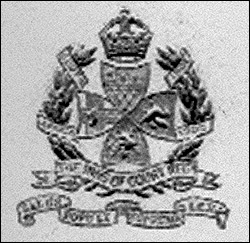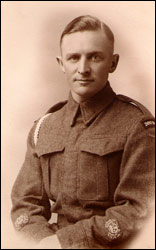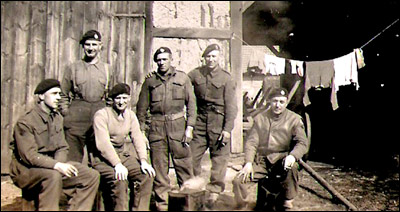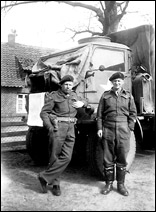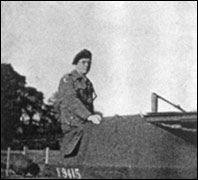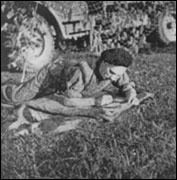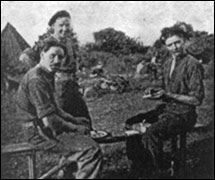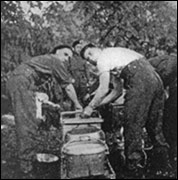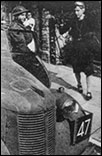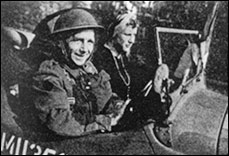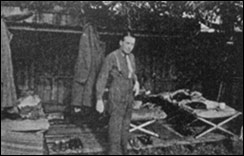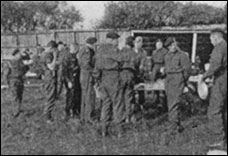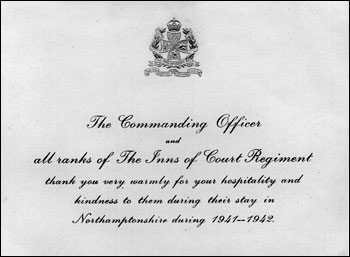| Article by Mr R J Long, (former Quartermaster of the Regiment), transcribed by Raylee Burton |
|||||||||||||||||||||
|
|||||||||||||||||||||
|
|||||||||||||||||||||
|
Inns of Court Regiment, RHQ & HQ Squadron
December 1940 - March 1942 |
|||||||||||||||||||||
|
After Dunkirk the War Office decided to expand the number of Armoured Divisions, at that time The Inns of Court was an officer producing unit at Sandhurst, so a lot of hard work was necessary to change their role to fighting unit, to achieve this a cadre of senior Warrant Officers, Sgts and other Junior N.C.O.s were transferred from the 13th/18th Royal Hussars and the 3rd Royal Tank Regt. to carry out the necessary training of men called up from civilian life.
The Orchard Room where I had my office was converted to the Quartermasters store and we also used the Box Factory for the storing of Anti-Gas equipment for the Regt, the Petrol Pumps at the bottom of Station Road, which were owned by Curly Pearson, much to his disgust and many moans were requisitioned for the Sqn’s use together with ones outside Charlie Ward’s cycle shop, but there were no problems there. The upstairs of the Horse and Groom in Bakehouse Lane was taken over for the Sgts Mess, I’m sure Alf Wilkins didn’t mind this as it must have improved his turnover, he was always very cheerful and helpful, he was badly gassed - I believe in the First World War. The men’s Cookhouse and Dining Hall was in the Preston Hall and the Hall was also used for the Saturday night dances, these proved quite popular both for the troops and the local girls, H.Q. Sqn. were lucky in the fact that amongst their ranks they had three or four professional musicians so they made up the Squadron’s Dance Band. The men were accommodated mainly in the Clubs in the town, the Cons, the Britt, Band Club and also the Assembly Rooms in Meeting Lane housed them all, they were much better off than in the draughty and cold huts at Blackdown and everyone soon settled down quite happily, the civilians-come-soldiers getting used to and accepting army life. H.Q. Sqn. Office, the office of the Regimental Medical Officer and the Medical Room was situated in the cottage (now demolished) opposite the Chapel, the R.S.M. and R.Q.M.S. were billeted in private houses where owners were paid the grand sum of 1/6d a night for the privilege!! The recreation ground tennis courts were extensively made use of, matches were played between Troops, Sqns, and other Regiments in the Division, competition was always fierce, the cricket ground opposite The Hall had a lot of use and here we had several matches against local teams, the use of the swimming pool in Polwell Lane was much appreciated and thanks for that must go to Mr. Grey. Papworths shop in the High Street was well patronised as it was about the only place during the day that the lads could get a “char and wad” (tea and cake). The Long Room over the Co-op was used as a canteen during the evenings, manned by volunteer ladies of the town who did a grand job helping to keep the lads happy. Here at Christmas we were able to put on a party for the local children and somehow, during those days of shortages, managed to get oranges but where they came from I wouldn’t know. On Christmas Day the usual army procedure was carried out during the serving of Christmas dinner, the troops were waited on by the Officers, W.O.s and Sgts, the C.O. attended these in each Sqn and drank the health of everyone at each one, I think it was a good job that there was no such thing as a breathalyser then. The above delayed Christmas dinner for the Officers, Sgts, etc, so theirs was held on Boxing Day where the wives of anyone visiting their husband and girlfriends were invited to attend. The last bus from Kettering was about 9pm and there were no taxis to call on, so anyone going to a dance (usually at The George) or to 2nd House pictures had to be prepared to walk back from Kettering, failing that there was Watts Cinema (The Bug House) to fall back on. The Duke, Red Cow and Waggon & Horses were the favourite pubs for the troops, keeping clear of the Horse & Groom which all the W.O’s and Sgts frequented, but very little trouble was experienced, if any at all. When the Alumasc was being built several of the lads put in a couple of hours during the evening (unofficially) when off duty, a blind eye was taken to this and it made a few extra shillings, probably to spend at the pub, for those employed. All exercises took place all over the country, a lot of our own exercises centered in and around the Cotswolds (where the C.O. had a farm) and when we returned there always seemed to be two or three ex farmers left behind, so we were told to repair any damage the troops had done to fences etc (a likely story!).
The role of the Regiment during operations was mainly one of reconnaissance either out in front of a Division or on a flank reporting back over the air any enemy activity seen, or to report any bridges held by the enemy or if not, whether they were blown. Our job was to see and not be seen, the information we reported could be vital to an operation. We were equipped with Daimler armoured cars and scout cars, in the later the driver sat at an angle and the cars could go almost as fast in reverse as forward which often got them out of sticky situations. A Troop was made up of one armoured car normally commanded by an officer and two scout cars with a sgt in command of the leading scout car. The armoured car had a two pdr. gun and a 7.92mm Besa machine gun with a crew of the officer, driver, and a wireless operator/gunner. The scout car a sgt in the leading car and probably a cpl in command of the 2nd car and a driver and wireless operator/gunner, it was armed with a 7.92mm Besa, these guns were purely for self-protection, defensive and not offensive, but they were capable of knocking out soft vehicles if necessary, but getting back enemy information was our main job.
Whilst in Burton Latimer live ammunition gunnery training was carried out at Linney Head in The vehicles in HQ Sqn were mainly three ton and fifteen cwt lorries which collected rations for the regiment from the R.A.S.C. supply depots and also carried the clothes for the Q/M, ammunition and petrol (in the field), the Sqn also supplied despatch riders for R.H.Q. After almost a year at Burton Latimer everyone was sorry when we heard we were moving on, but we knew the time had to come, the kindness shown by everyone during our stay was very much appreciated. The time and training we experienced whilst in Burton Latimer made us sure we were competent and ready for whatever happened in the future.
Our next port of call (one of four or five before we took part in the Normandy Landings) was at Wimpole Hall in Cambridgeshire, not so comfortable as our Burton Latimer billets as the regiment was under canvas. Click here to read extracts of the Inns of Court Regiment magazine
|
|||||||||||||||||||||
